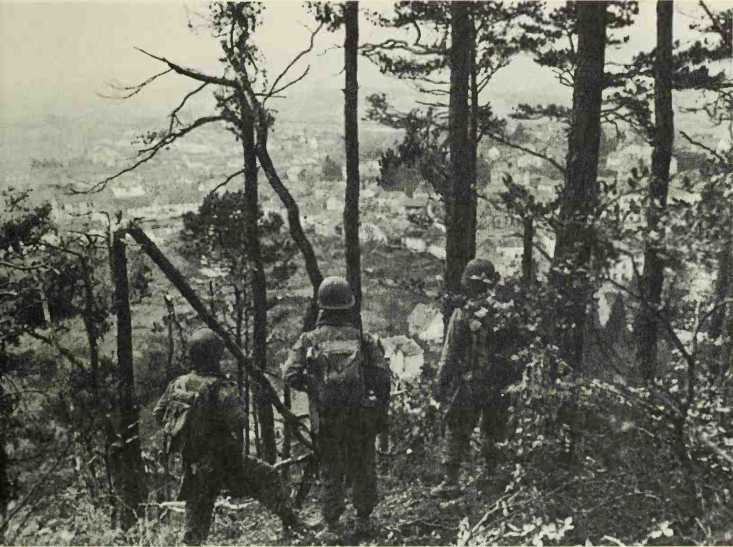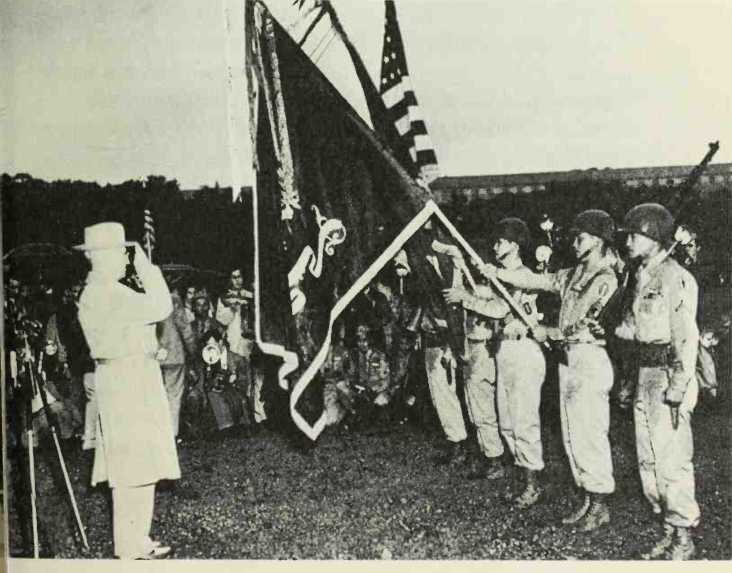On a gray and rain-soaked july afternoon in 1946, the 442nd Regimental Combat Team marched smartly down Constitution Avenue in Washington toward the White House and ceremonies honoring them on their return from war. They stood rigidly at attention while President Harry Truman fixed the Presidential Unit Citation to their regimental colors.
For the 442nd Combat Team, World War II was especially hard. They had been assigned to beat back the Germans in some of the toughest fighting of the European war.
That was only part of the story. The 442nd Combat Team were all Nisei—American-born Japanese—except for a sprinkhng of officers. As Japa-nese-Americans, they also had to fight prejudice at home.
Executive Order 9066, signed by President Roosevelt, which went into effect 74 days after Pearl
Harbor, uprooted all Japanese-Americans on the Pacific Coast and assigned them to “internment camps” in isolated parts of Arkansas, Colorado, Utah, and other states for “the duration of the war.” Each person was allowed to bring only the personal belongings that would fit into a suitcase or barracks bag.
Families were torn apart, personal relationships destroyed, and jobs lost. It has been estimated that the 110,000 Japanese-Americans affected by the order lost $400 milhon. No price tag can be put on the heartache they were made to endure.
In spite of Executive Order 9066, Nisei by the hundreds pleaded for the right to fight for their country. But the government refused to accept them. In fact, in March 1942, they were classified “4C, Enemy Aliens,” by the Selective Service Board.
Six months after the Pearl Harbor attack, the War Department (it became the Department of Defense in 1949) agreed to put soldiers of Japanese roots in a special combat unit, the 100th Infantry Battalion. The excellent training record of the 100th Infantry Battalion convinced officials to form the 442nd Regimental Combat Team on February 1, 1943.
The Nisei were delighted. Tens of thousands of Japanese-Americans volunteered to join the unit. But the 442nd Combat Team could accommodate only 4,500 men.
On April 13, 1943, the first truckload of Nisei volunteers arrived at Camp Shelby, Mississippi, just outside Hattiesburg, to begin Army basic training. Most of the soldiers at Camp Shelby accepted the men of the 442nd Combat Team. But there were some who taunted them as “dirty Japs.” They would sneer as they passed by. Others held the suspicion that the Nisei represented a “fifth column,” that they were in sympathy with Japan and ready to act on the country’s behalf at the first signal.
Yet the Nisei had never thought of themselves as being anything but American. In an effort to show their true feelings, they attacked basic training with starthng fury.
“We set out to break every record in the Army,” says Harry Takagi, now Washington representative of the Japanese Citizens League, but in 1943 a private with the 442nd Combat Team. “We felt we were fighting for the rights of all Japanese-Americans. If we failed, it would reflect discredit on all Japanese-Americans. We could not let that happen.”
Nisei recruits struck out at each bayonet dummy as though it were an actual enemy. They scrambled over obstacle courses as if their lives depended on it. They would march in quick time until they seemed ready to drop—and then break into a brisk trot.
In combat exercises. Nisei recruits could never be convinced a hopeless position was a lost cause. They refused to give up. Any assault they launched usually ended in hand-to-hand combat.
Sometime during their training, the unit adopted an official motto—“Go for Broke!” It was an expression used by professional gamblers in Hawaii, and meant “Shoot the Works!”
Once training was completed, a few hundred of the Nisei were shipped to Africa to serve as replacements for soldiers in the 100th Infantry Battalion. But the bulk of the men waited and waited. Months went by. The Nisei griped about being stuck in the “Battle of Hattiesburg.”
At last their turn came. In May 1944, the 442nd Combat Team sailed for Italy. At about the same time they arrived there, the first of a million-man invasion force was landing on the beaches of Normandy in France, about 600 miles to the northwest. The battle for western Europe was on.
The 442nd Combat Team was given an important but unglamorous role to play. They were to be part of the Alhed force being used to keep German forces occupied in Italy. If the Germans were able to shift these units out of Italy and to the French front, it could jeopardize the prospects of victory in France.
Soldiers of the 442nd Combat Team went into action for the first time on June 26, 1944 at Suvereto, storming the town behind a wall of mortar fire. Nothing the Germans were able to do could stop them. The enemy finally broke and retreated.
During the next three months, the 442nd Combat Team pressed north, its Go for Broke attacks driving the enemy forces deeper into the mountains. One day became hke every other. Towns and places all seemed the same—Sassetta, Castagneto, Orciano, Livorno.
Acts of bravery became common. Private First Class Kiichi Koda found enemy troops entrenched in a castle. After lobbing grenades through the castle windows, he led three of his buddies inside to finish the job with bullets and bayonets. Pfc. Koda died in the room-to-room fighting, but he and his buddies killed ten of the enemy. Three other Germans were captured and all of the enemy machine guns were

THREE MEMBERS OF THE 442ND REGIMENTAL COMBAT TEAM LOOK DOWN ON A FRENCH VALLEY NOT LONG BEFORE THE “LOST BATTALION” BATTLE. (U. S. Army)
Put out of action.
Staff Sergeant Kazuo Masuda was another Nisei hero. He crawled 200 yards through enemy fire to bring back a 60-mm mortar. But he was unable to retrieve the baseplate that supported the mortar when it was being fired. So Sergeant Masuda removed his helmet and used it as a baseplate. For 12 hours, repeatedly going back for more rounds, he kept the mortar firing. He single-handedly threw back two German counterattacks.
By mid-September 1944, the 442nd had wrested control from the Germans of every foot of the 50 rugged miles between Suvereto and Vecciano, north of Pisa. But what the men of the unit really wanted was
A chance to participate in the bigger war in France.
The 442nd got that chance in October, when the unit received orders to join up with the 36th Division of the Seventh Army. The 36th Division had battered enemy strongholds throughout France on its drive to reach Germany. But now they were stalled in the bitter fighting in the Vosges Mountains of northeast France. Hitler’s army, its back to the German border, had been ordered to “fight to the last man.”
The terrain was more rugged than anything the men of the 442nd had experienced in Italy. The mountains rose many hundred feet from the valley floor and were covered with tall pines and thick underbrush. When the Germans lobbed an artillery shell toward them, it burst in the pines, showering the men with jagged shell fragments and deadly chunks of splintered wood.
The 442nd assaulted and took one hill after another. Sometimes they would lose as many as 20 men when a shell burst above the trees. And almost every time they gained a sizable piece of ground, the Germans would counterattack.
Day and night, the enemy guns never stopped firing. Winter was approaching and many of the men spent their nights in foxholes half-filled with frozen water.
The 442nd had not been in France for very long when it received one of the toughest assignments of the war. The 1st Battalion of the 141st Infantry Regiment (36th Division) had gotten cut off and now was surrounded by German troops near a hill in the Vosges Mountains. The battahon had been ordered to fight its way back, but had been unable to do so.
Communications and supply lines to the unit had been cut. The Germans were closing in on all sides. The 279-man unit had become known as the ''lost battalion.” The 442nd Combat Team was given the mission of rescuing them. The men moved out in the hours before daybreak. When the Germans became aware of the 442nd’s advance, they began pounding them with everything they had—artillery, mortars, machine guns, and hand grenades. But the 442nd pressed the attack, trying to cut a path through the enemy lines.
Staff Sergeant Gordon Yamashiro crept up on a road block and attacked a nearby machine gun nest with his rifle. He killed the three men manning the machine gun. A second machine gun opened fire on him. He attacked it and killed the second crew.
Sergeant Yamashiro began laying down a screen of fire to cover the advance of his men. Then a sniper killed him. But he had driven a wedge in the enemy’s defense. His men charged, killing every enemy soldier who didn’t surrender, and they took the roadblock.
Meanwhile, the situation was growing worse for the "lost battalion.” Artillery had fired in chocolate bars and emergency rations to the trapped men, but they were becoming desperately low on water and medical supplies. Ammunition was running out. The battalion could not hold out much longer.
The 442nd was ordered to "push through at any cost.” As the men picked their way along narrow paths and ridges, they hit a minefield. They decided to go through it. "Go for broke!” some of the men shouted. Before they got beyond the minefield, German guns opened up on them. But they did not fall back.
Men fired from the hip as they advanced. They rushed in with hand grenades. They fixed bayonets and charged German positions.
By the end of the fourth day, the 442nd was less than half a mile from the “lost battalion.” They had destroyed most of the enemy forces on the mountain. But half of their men were dead or wounded.
On the afternoon of the next day, following a heavy artillery barrage that had been launched in their support, the first men of the 442nd reached the “lost battalion.” “There were a lot of tears but not much cheering,” one survivor recalled. “We were all too tired to cheer.”
For the next several months, the 442nd rested. New men were assigned to the unit to replace those who had been killed or wounded.
In March 1945, the 442nd received orders to return to Italy. German troops were holding the Gothic Line, a chain of interlocking defensive positions across the barren mountains of northern Italy. The 442nd was assigned to drive the enemy from the westernmost peaks.
For sheer heroism, their first strike, an assault on fortifications atop Mount Folgorita, may be unmatched in military history. Two units of the 442nd began a wide flanking attack, climbing almost straight up, mostly on their hands and knees. Wearing full combat gear, they scaled the mountains in total darkness. Complete silence had to be maintained. Medals and dogtags were wrapped with tape. Coins had to be tossed away. No one could speak.
Some men slipped and fell to their death. But no one cried out and no one turned back.
At the summit, they took the startled German troops by surprise. Their final charge killed or scattered the enemy defenders.
On one ridge, Private First Class Sadao Mu-nemori’s squad was pinned down by machine gun fire. Private Munemori successfully attacked two of the machine guns. As he was returning to his men, a German hand grenade struck his helmet, bounced off, and rolled toward two of his men. Private Munemori dived on the grenade, smothering the blast with his body. He gave up his life rather than see his men die.
PRESIDENT HARRY S. TRUMAN AWARDS THE PRESIDENTIAL UNIT CITATION TO THE 442ND REGIMENTAL COMBAT TEAM. (U. S. Army)

By the early part of May, the 442nd Combat Team received the Presidential Distinguished Unit Citation from President Truman, marking the seventh time the unit had won the award. In 20 months of combat, the 442nd Combat Team had earned over 18,000 individual awards, including one Medal of Honor (awarded to Private First Class Munemori), more than 9,400 Purple Hearts, 52 Distinguished Service Crosses, and 588 Silver Stars. The Niseis’ record was unexcelled.




 World History
World History









